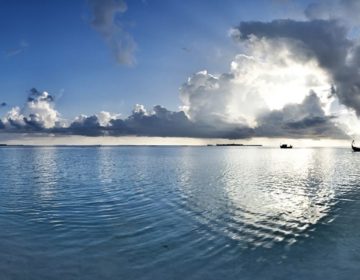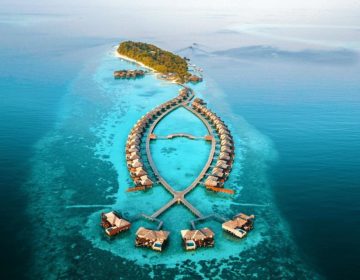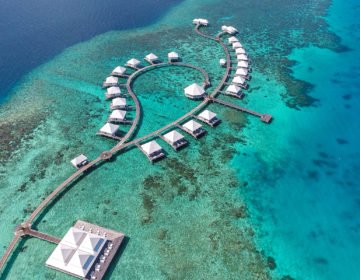Long before the introduction of divine equipment to the Maldives, fishermen were free-diving to well more than 30 meters to retrieve lost anchors, cargo from wrecked vessels, baitfish and pearl shell.
Young men learning to dive discovered that the deeper they went, the greater the pain in their foreheads and ears became. The Valsalva method of equalizing was not practiced by Maldivians. Instead, when pain was felt in their air spaces while descending, they clenched a fist and banged their forehead to relieve the pressure. The term kamalhafalhun was used to describe this method.
Divers were often unable to equalize and sometimes surfaced with blood streaming from their noses. Bleeding was regarded as a rite of passage into the adult world of deep diving. The occasion was carried throughout their lives, much like today’s divers carry a certification card.
The depth that a diver could go was most important to the diving dhoni captain. He wanted only those who could go deep. To determine which divers went deepest, each diver was given a white cloth to wear around his waist. Since there were no depth meters, depth was determined by visibility. The deeper the diver went, the less of the white cloth could be seen. Those judged by the captain as going the deepest were selected to join the next diving expedition.
 The depth that a diver could go was most important to the diving dhoni captain.
The depth that a diver could go was most important to the diving dhoni captain.
Black coral and pearl shell diving was carried out by four or five divers in an eight-meter dhoni. This was steadily rowed along the reef edge until they could see coral trees below in the clear, calm seas. If the sea became choppy, then coconut oil was spilled into the water to improve visibility at the surface. Mostly divers worked in the calmer months, not June or July.
When a large piece of black coral eight to ten centimeters thick was found, the first diver carried a rope from the surface and tied it to the stem of the bush before surfacing. A second diver then used the rope to descend quickly to the bush and begin cutting. Sometimes a third or fourth diver would repeat the procedure until the coral tree was cut free and pulled to the surface. Divers continued with this method, staying under the water for long periods.

Pearl shell grows on black coral trees, and some trees have as many as 15 or 20 shells growing on them. It takes on average 50 or 60 shells to produce one pearl, and the pearl is found by carefully sifting through the meat of the shell. Before bringing the tree and pearl shell to the surface, divers used to place the tree in a hessian bag. If the tree was too big, then hessian was wrapped around the base of the tree.
Divers believed that if they did not use the hessian on the trees, then the shells would spit out their valuable pearl. Pearls are used not only for decorating rings and broaches but for medicinal purposes. When used as medicine, pearls are put in a container and melted over a fire. The grey residue remaining is used as a herbal medicine for heart patients and people with mental illness.
 Pearls are used not only for decorating rings and broaches but for medicinal purposes.
Pearls are used not only for decorating rings and broaches but for medicinal purposes.
Diving for baitfish without the aid of masks or fins was sometimes dangerous work. The baitfish most sought after by fishermen is called bodhi and is used to catch tuna and bonito. To catch this baitfish, fishermen lay a square carpet of coconut fiber much like a cricket pitch, called a Madhuri, onto the ocean floor near a reef. A diver then swam down with a handful of smelly fish, known as filimas, and placed it on the carpet to attract the baitfish. The diver was also required to check if the baitfish were feeding and instructing the fishermen when to pull up the carpet.
Divers handling smelly fish are vulnerable to attack from sharks lurking near the reef and stories of encounters with sharks are legendary. When diving in areas where sharks were found, divers carried palm leaves into the water to wave at sharks if threatened. Often, because the diver was not wearing a mask, he would not see the shark coming.
Diving for anchors has always been an essential task for the divers. When the Indians from Bombay were busy trading in the Maldives in the 1940s, they came in their baggalas laden with cargo, anchoring in the waters of Malé’s outer harbor. Occasionally an anchor became stuck on the reef, or an anchor rope broke in a storm, and the anchor was lost. Water in the outer harbor is up to 50 meters deep. If a good diver was not to be found in Malé then a message was dispatched to Faadhippolhu Atoll – an atoll renowned for its divers – for the services of a diver to recover the anchor.

Today, scuba gear is used by many islanders to collect products of the sea, but it is refreshing to see traditional baitfish collecting methods still employed in the outer atolls with the skill of bait divers remaining an integral part of the fishing process.
Head to the pristine waters of the Maldives to learn how to freedive or explore the magnificent reefs while staying at some of these spectacular resorts.
(Source: Dive Maldives: A Guide to the Maldives Archipelago. Tim Godfrey. Atoll Editions, 2015)



